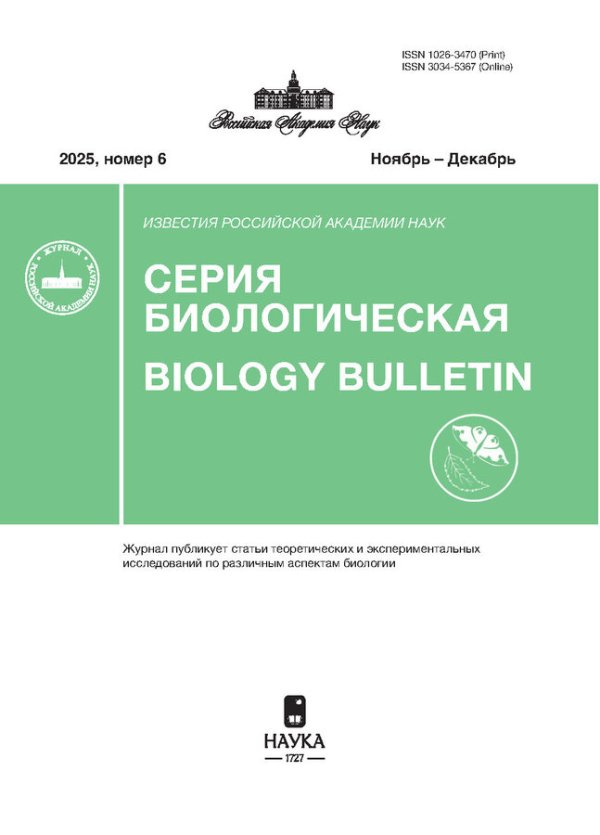Эктопаразитические клещи – переносчики бактериальных симбионтов среди насекомых
- Авторы: Шайкевич Е.В.1, Горбачева А.А.1, Романов Д.А.1
-
Учреждения:
- Федеральное государственное бюджетное учреждение науки Институт общей генетики им. Н.И. Вавилова Российской академии наук
- Выпуск: № 3 (2023)
- Страницы: 258-268
- Раздел: МИКРОБИОЛОГИЯ
- URL: https://journals.rcsi.science/1026-3470/article/view/135522
- DOI: https://doi.org/10.31857/S1026347023700142
- EDN: https://elibrary.ru/MUQTVC
- ID: 135522
Цитировать
Полный текст
Аннотация
Передающиеся по наследству эндосимбиотические бактерии из родов Rickettsia, Wolbachia и Spiroplasma вызывают гибель потомства мужского пола у божьих коровок (Coleoptera, Coccinellidae). Как правило, бактерии передаются через цитоплазму материнской яйцеклетки потомству – по вертикали. В дополнение к вертикальной передаче, появляется все больше данных о горизонтальном переносе симбионтов между неродственными таксонами насекомых. Потенциальными переносчиками эндосимбиотических бактерий могут быть паразиты насекомых, например, клещи. Паразитический клещ божьих коровок Coccipolipus hippodamiae (McDaniel & Morrill, 1969) (Acarina: Podapolipidae) встречается в природных популяциях Coccinellidae. В данной работе впервые доказана способность C. hippodamiae заражаться Wolbachia и Spiroplasma от хозяев и распространять бактерий среди жуков-кокцинеллид.
Ключевые слова
Об авторах
Е. В. Шайкевич
Федеральное государственное бюджетное учреждение науки Институт общей генетики им. Н.И. Вавилова Российской академии наук
Автор, ответственный за переписку.
Email: elenashaikevich@mail.ru
Россия, 119333, Москва, ул. Губкина, 3
А. А. Горбачева
Федеральное государственное бюджетное учреждение науки Институт общей генетики им. Н.И. Вавилова Российской академии наук
Email: elenashaikevich@mail.ru
Россия, 119333, Москва, ул. Губкина, 3
Д. А. Романов
Федеральное государственное бюджетное учреждение науки Институт общей генетики им. Н.И. Вавилова Российской академии наук
Email: elenashaikevich@mail.ru
Россия, 119333, Москва, ул. Губкина, 3
Список литературы
- Горячева И.И., Блехман А.В., Андрианов Б.В., Горелова Т.В., Захаров И.А. Генотипическое разнообразие Wolbachia pipientis в нативных и инвазивных популяциях Harmonia axyridis Pall., 1773 (Coleoptera, Coccinellidae) // Генетика. 2015. Т. 51. № 8. С. 857–863.
- Захаров И.А., Эйдельберг М.М. Паразитический клещ Coccipolipus hyppodamia McDaniel et Morrill (Tarsonemina, Podapolipidae) в популяциях двухточечной коровки Adalia bipunctata L. (Coleoptera, Coccinellidae) // Энтомологическое обозрение. 1997. Т. 76. № 3. С. 680–683.
- Захаров И.А., Шайкевич Е.В. Полиморфизм мтДНК в петербургской популяции Adalia bipunctata и его связь с зараженностью симбиотической бактерией Spiroplasma // Экологическая генетика. 2011. Т. 9. № 1. С. 27–31.
- Романов Д.А., Матвейкина Е.А. Harmonia axyridis (Pallas, 1773) (Coleoptera: Coccinellidae) в г. Москве и г. Ялте: ее конкуренция с нативными видами кокцинеллид и влияние паразитоидов на ее численность // Российский журн. биологических инвазий. 2021. № 4. С. 114–133.
- Шайкевич Е.В., Захаров И.А., Хонек А. Экологическая генетика жуков рода Adalia: изменчивость и симбиотические бактерии в европейских популяциях десятиточечной божьей коровки Adalia decempunctata // Экологическая генетика. 2019. Т. 17. № 4. С. 37–45.
- Шайкевич Е.В., Ившина Е.В., Захаров И.А. Полиморфизм митохондриальной ДНК и распространение цитоплазматических симбионтов в популяциях двуточечной божьей коровки Adalia bipunctata // Генетика. 2012. Т. 48. № 5. С. 666–671.
- Эйдельберг М.М. Клещи семейства Podapolipidae (Heterostigmata, Tarsonemina) Украины и сопредельных территорий с описанием нового вида // Вестн. зоологии. 1994. № 1. С. 37–42.
- Ahmed M.Z., Breinholt J.W., Kawahara A.Y. Evidence for common horizontal transmission of Wolbachia among butterflies and moths // BMC Evol. Biol. 2016. V. 16. P. 118.
- Baldo L., Ayoub N.A., Hayashi C.Y., Russell J.A., Stahlhut J.K., Werren J.H. Insight into the routes of Wolbachia invasion: high levels of horizontal transfer in the spider genus Agelenopsis revealed by Wolbachia strain and mitochondrial DNA diversity // Mol Ecol. 2008. V. 17(2). P. 557–569.
- Brown A.N., Lloyd V.K. Evidence for horizontal transfer of Wolbachia by a Drosophila mite // Exp. Appl. Acarol. 2015. V. 63(3). P. 301–311.
- Ceryngier P., Roy H.E., Poland R.L. Natural enemies of ladybird beetles // In: Ecology and behaviour of the ladybird beetles (Coccinellidae) / Ed. by Hodek I., van Emden H.F., Honek A. Chichester: Wiley-Blackwell, 2012. P. 375–443.
- Folmer O., Black M., Hoeh W., Lutz R., Vrijenhoek R. DNA primers for amplification of mitochondrial cytochrome c oxidase subunit I from diverse metazoan invertebrates // Mol. Mar. Biol. Biotechnol. 1994. V. 3. P. 294–299.
- Gerth M., Röthe J., Bleidorn C. Tracing horizontal Wolbachia movements among bees (Anthophila): A combined approach using multilocus sequence typing data and host phylogeny // Molecular ecology. 2013. V. 22. https://doi.org/10.1111/mec.12549
- Goryacheva I., Blekhman A., Andrianov B., Zakharov I. Heritable bacterial endosymbionts in native and invasive populations of Harmonia axyridis // Biol. Invasions. 2017. V. 19. P. 493–502.
- Goryacheva I., Blekhman A., Andrianov B., Romanov D., Zakharov I. Spiroplasma infection in Harmonia axyridis – diversity and multiple infection // PLoS One. 2018. V. 13(5). e0198190.
- Hurst G.D.D., Sharpe R.G., Broomfield A.H., Walker L.E., Majerus T.M.O., Zakharov I.A., Majerus M.E.N. Sexually transmitted disease in a promiscuous insect, Adalia bipunctata // Ecological Entomology. 1995. V. 20(3). P. 230–236.
- Ilinsky Y., Kosterin O.E. Molecular diversity of Wolbachia in Lepidoptera: prevalent allelic content and high recombination of MLST genes // Mol Phylogenet Evol. 2017. V. 109. P.164–179.
- Jaenike J., Polak M., Fiskin A., Helou M., Minhas M. Interspecific transmission of endosymbiotic Spiroplasma by mites // Biol. Lett. 2007. V. 3(1). P. 23–25.
- Knell R.J., Webberley K.M. Sexually transmitted diseases of insects: distribution, evolution, ecology and host behaviour // Biological Reviews. 2004. V. 79(3). P. 557–581.
- Li H., Shu X., Meng L., Zhou X., Obrycki J.J., Li B. Prevalence in maternally-inherited bacteria in native and invasive populations of the harlequin ladybird beetle Harmonia axyridis // Biol. Invasions. 2021. V. 23. P. 1461–1471.
- O’Neill S.L., Giordano R., Colbert A.M., Karr T.L., Robertson H.M. 16S rRNA phylogenetic analysis of the bacterial endosymbionts associated with cytoplasmic incompatibility in insects // Proc. Natl. Acad. Sci. USA. 1992. V. 89(7). P. 2699–2702.
- Osaka R., Watada M., Kageyama D., Nomura M. Detection of Spiroplasma from the mite Macrocheles sp. (Acari: Macrochelidae) ectoparasitic to the fly Drosophila hydei (Diptera; Drosophilidae): a possible route of horizontal transmission // Symbiosis. 2013. V. 60(2). P. 79–84.
- Pietri J.E., DeBruhl H., Sullivan W. The rich somatic life of Wolbachia // MicrobiologyOpen. 2016. V. 5(6). P. 923–936.
- Raak-van den Berg C.L., van Wielink P.S., de Jong P.W., Gort G., Haelewaters D., Helder J., van Lenteren J.C. Invasive alien species under attack: natural enemies of Harmonia axyridis in the Netherlands // BioControl. 2014. V. 59(2). P. 229–240.
- Rhule E.L., Majerus M.E.N., Jiggins F.M., Ware R.L. Potential role of the sexually transmitted mite Coccipolipus hippodamiae in controlling populations of the invasive ladybird Harmonia axyridis // Biological Control. 2010. V. 53(2). P. 243–247.
- Riddick E.W. Ectoparasitic mite and fungus on an invasive lady beetle: parasite coexistence and influence on host survival // Bulletin of Insectology. 2010. V. 63(1). P. 13–20.
- Schulenburg J.H., Hurst G.D., Tetzlaff D., Booth G.E., Zakharov I.A., Majerus M.E. History of infection with different male-killing bacteria in the two-spot ladybird beetle Adalia bipunctata revealed through mitochondrial DNA sequence analysis // Genetics. 2002. V. 160. P. 1075–1086.
- Shaikevich E.V., Romanov D.A., Zakharov I.A. The diversity of Wolbachia in a single Adalia bipunctata (Coleoptera: Coccinellidae) population: correlations with host phylogeny and male-killing // Symbiosis. 2021. V. 85(2). P. 249–257.
- Shaikevich E.V., Zakharov I.A. Biodiversity in geographically remote natural populations of Adalia ladybirds (Coleoptera: Coccinellidae) // In: Beetles: Biodiversity, Ecology and Role in the Environment / Ed. by Stack C. Nova Science Publishers, Inc., 2015. P. 205–226.
- Tamura K., Stecher G., Peterson D. et al. MEGA6: Molecular Evolutionary Genetics Analysis version 6.0 // Molecular Biology and Evolution. 2013. V. 30. P. 2725–2729.
- Webberley K.M., Hurst G.D.D. The effect of aggregative overwintering on an insect sexually transmitted parasite system // J. Parasitology. 2002. V. 88(4). P. 707–712.
- Webberley K.M., Hurst G.D.D., Husband R.W., Schulenburg J.H.G.V.D., Sloggett J.J., Isham V., Buszko J., Majerus M.E.N. Host reproduction and a sexually transmitted disease: causes and consequences of Coccipolipus hippodamiae distribution on coccinellid beetles // J. Animal Ecology. 2004. V. 73(1). P. 1–10.
- Webberley K.M., Tinsley M.C., Sloggett J.J., Majerus M.E.N., Hurst G.D.D. Spatial variation in the incidence of a sexually transmitted parasite of the ladybird beetle Adalia bipunctata (Coleoptera: Coccinellidae) // European J. Entomology. 2006. V. 103(4). P. 793–797.
- Werren J.H., Zhang W., Guo L.R. Evolution and phylogeny of Wolbachia: reproductive parasites of arthropods // Proc. Biol. Sci. 1995. V. 261(1360). P. 55–63.













